- BEACH (SAFETY or WARNING) FLAG (or PENNANT)
- A flag or pennant from one of several different systems for signalling the
condition of a beach, the state of the ocean or weather at that particular point,
and/or to what degree bathing safety precautions are in place – a bathing or surfing
flag/pennant, a weather or weather-warning flag/pennant, a shark alert or alarm flag/pennant, a wind, windsurf or windsurfing danger
flag/pennant or similar - but see ‘blue flag’ (also
‘red flag 1)’ and
‘storm warning flag’).

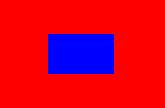
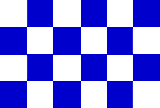
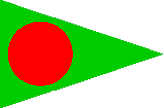
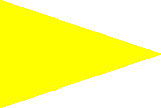
Some Beach Flags and Pennants, UK, The Netherlands, Portugal and France (fotw)
- BEACH QUALITY FLAG
- See ‘blue flag’
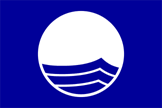
Beach Quality/Blue Flag, European (fotw)
- BEAKED
- The heraldic term which may be used when the beak of a bird or a bird-like creature is of a different
tincture than the body (see also
‘appendix V’, ‘armed 2)’,
‘attired’,
‘gorged’,
‘jelloped’,
‘langued’,
‘membered’ and
‘tincture’).



Flag of Filisur, Switzerland (fotw); Arms and Flag of
Brandenburg, Germany (fotw)
- BEAM CROSS
- An accurate but seldom used translation (balken meaning a “balk”, “bar” or “beam” of
wood) of the German term balkenkreuz - see ‘balkenkreuz’.
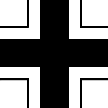
- BEAM(S)
- 1) An expanding stripe (or stripes) which usually - but not exclusively - expand from a central point in order to represent
a shaft (or shafts) of light – rays – but see
‘radiating 1)’
(also ‘expanding stripe(s)’).
2) A term sometimes incorrectly used to describe a stripe (or stripes) in place of the heraldic equivalents – see
‘bar’,
‘bend’,
‘fess’ and
‘pale’.
3) The term may also be used to describe a horizontal arm such as those seen on an anchor, cross or yard
(see also ‘cross 1)’ and
‘yard’).
4) See ‘beamed’.

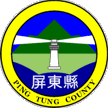
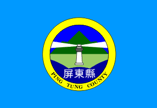

Flag of the Air Force, Russia (fotw); Emblem and Flag of P’ing-tun, Taiwan (fotw); Flag of Kryhlakivka, Ukraine (fotw)
- BEAMED
- A term sometimes incorrectly used in place of pointed - see ‘pointed’
(also ‘rays 1)’).
- BEARING
- See ‘charge’ and
‘charged’.
- BEAUFORT
- An early 18th Century alternative term, now obsolete, for bunting – see
‘bunting 1)’ (also
‘bewper’ and ‘breadth 2)’).
- BECKET
- A loop at the end of the hoist line of a flag that fastens to a toggle at
the end of the halyard when hoisting a flag – a running eye – but see ‘eye splice’ (also ‘halyard’,
‘hoistline’,
‘running eye and toggle’
and ‘toggle’).
![[becket]](../images/v/vxt-d038a.gif)
- BED SHEET FLAG (or BSF)
- See ‘logo on a bed sheet’.
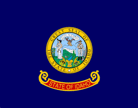
Flag of the State of Idaho, US (fotw)
- BEEF PENNANT
- See ‘bullock pennant’.
Please note, information suggests that
this term - a direct translation of the French "flamme de boeuf" - may have ceased after 1792,
however, this is not certain and no equivalent signal can be found in contemporary British naval
sources. Nonetheless supply vessels of the late 19th and early 20th Century which were carrying
foodstuffs to the Royal Navy are known to have flown a ’beef flag’.
- BELAYING PIN
- An increasingly obsolete method of securing the halyard
by means of movable vertical pins (fitted into a frame or rack at the foot of the
mast) and now largely replaced by the cleat - a tack pin or jack pin
(see also ‘cleat’
and ‘halyard’).
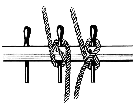
Wikipedia
- BEND
- The heraldic term for a diagonal stripe which runs for the upper dexter to the lower
sinister of a shield, a banner of arms or any quartering thereof, and which (in strict
heraldic usage) should occupy about one-third of the field when charged, and one-fifth
when plain – but see ‘Appendix VI’,
‘Appendix IX’ and
‘descending diagonal’
(also ‘banner of arms’, ‘dexter’,
‘in bend’,
‘per bend’,
‘quartering 1)’,
‘sinister’ and
‘triangular panel 2)’).

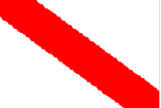
Example; Flag of Strasbourg, France (fotw)
- BEND ON (or BEND ONTO)
- (v) A nautical term for securing two pieces of rope together as in attaching
the hoistline of a flag to the halyard of a flag pole or mast (see
‘halyard’ and
‘hoistline’).
- BEND SINISTER
- The heraldic term for a diagonal stripe which runs for the lower dexter to the upper
sinister of a shield, a banner or arms or any quartering thereof, and which (in strict
heraldic usage) should occupy about one-third of the field when charged, and one-fifth when
plain – but see ‘Appendix VI’,
‘Appendix IX’ and
‘ascending diagonal’
(also ‘banner of arms’, ‘dexter’,
‘in bend sinister’,
‘per bend sinister’,
‘quartering 1)’,
‘sinister’ and
‘triangular panel 2)’).


Badge of the Fire Brigade, Austria (official website);
Flag of Frankerandeel, The Netherlands (fotw)
- BEND SINISTER WAVY
- See ‘bend’ (also ‘wavy’).
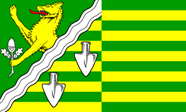
Flag of Probsteierhagen, Germany (fotw)
- BEND WAVY
- See ‘bend’ (also ‘wavy’).
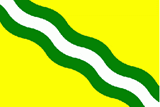
Flag of Lentegí, Spain (Klaus-Michael Schneider)
- BENDLET and BENDLET SINISTER
- A diminutive of bend and bend sinister, nominally half the width of a bend but often much narrower,
sometimes wavy and usually (but not invariably) appearing in numbers of two or more – see
‘Appendix VI’.
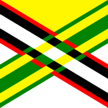

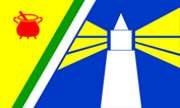
Flag of Grolley, Switzerland (fotw); Arms and Flag of
Südtondern, Germany (fotw)
- BENDLET WAVY and BENDLET SINISTER WAVY
- See ‘bendlet and bendlet sinister’
(also ‘wavy’).
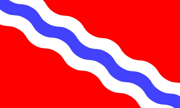

Flag of Bredenbek, Germany (fotw); Arms of
Wesenberg, Germany (fotw)
- BENDWISE (or BENDWISE SINISTER)
- 1) In traditional heraldry see ‘in bend’
and ‘in bend sinister’.
2) In some heraldic usage this term relates specifically to the axis of a charge or charges,
rather than to its, or their position, on a shield, a banner of arms or a flag – but see
‘in bend’
and ‘in bend sinister’ as referenced above.

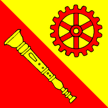
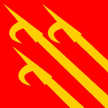
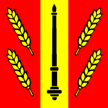
Flag of Haut Rhin, France (fotw); Flag of
Le Sentier, Switzerland (fotw); Flag of
Jondal, Norway (fotw); Flag of Eiken, Switzerland (fotw)
- BENDY
- 1) The heraldic term for the division of a shield, a banner of arms or any quartering
thereof, into four or more usually (but not invariably) equal bends or bendlets, and
running from the upper dexter to the lower sinister in alternating tinctures – but see
‘Appendix VI’,
‘bend’ and
‘multi-stripe’
(also ‘banner of arms’, ‘dexter’,
‘quartering 1)’,
‘sinister’ and
‘tincture’).
2) See ‘wavy’.

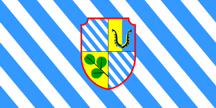

Example; Flag and Arms of Šmarje pri Jelšah, Slovenia (fotw)
- BENDY SINISTER
- The heraldic term for the division of a shield, a banner of arms or any quartering
thereof, into four or more usually (but not invariably) equal bends or bendlets, and
running from the lower dexter to the upper sinister in alternating tinctures – but see
‘Appendix VI’,
‘per bend sinister’ and
‘multi-stripe’
(also ‘banner of arms’, ‘dexter’,
‘quartering 1)’,
‘sinister’ and
‘tincture’).


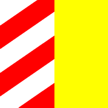
Example; Flag of Wasseramt, Switzerland (fotw);
Flag of Trüllikon, Switzerland (fotw)
- BENT
- See ‘embowed’.
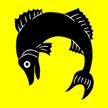
Flag of Fischbach, Switzerland (fotw)
- BETHEL FLAG
- The flag of the Bethel Union, a seaman’s missionary organization, and occasionally flown
in the 19th Century by some British and US merchant vessels to indicate that a church service
was taking place (see also ‘church pennant’ and
‘flying angel flag’).
![[Bethel flag]](../images/v/vxt-d040a.gif)
![[Bethel flag]](../images/v/vxt-d040.gif)
- BETSY ROSS FLAG
- A pattern of the stars and stripes whose canton carried thirteen five-pointed stars arranged in a
circle, which according to legend was ordered by George Washington in 1776 and sewn by Betsy Ross
of Philadelphia (see also
‘continental colours’,
‘eagle standard’,
‘Franklin flag’,
‘great star flags’,
‘old glory’,
‘quincunx’,
‘stars and stripes’ and
‘star-spangled banner’).
![[Betsy Ross flag]](../images/v/vxt-d502.gif)
The Betsy Ross Pattern US National Flag (fotw)
Please note that the US flag had no official star pattern until 1818,
at which time the 20-star flag (and all subsequent flags) had official patterns for military
purposes. Since 1918 (the 48-star version), the flag has had an official pattern for all purposes,
therefore, the type above is likely one of many patterns used during the period 1777-1795.
- BEWPER (OR BEWPERS)
- A 17th Century term, now obsolete, for bunting (see also
‘bunting 1)’).
- BEZANT (OR BESANT)
- The heraldic term for a particularly (but not exclusively) gold or yellow disc –
a roundel or (see ‘hurt’,
‘roundel
3)’, ‘plates’ and
‘torteau’).


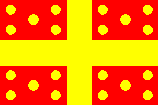

From left: example; Standard of the Duke of Cornwall, UK (fotw);
Flag of Harelbeke, Belgium (fotw); Flag of Geuensee, Switzerland (fotw)
Notes
1) In strict English heraldic usage
this term should only be employed when the charge described is gold/yellow
(“or”) - see ‘tinctures’ in ‘appendix III’.
2) The term, dating from the time of the Crusades, is derived from a gold coin of Byzantium.
- BICOLOUR (BICOLOR or BI-COLOUR)
- 1) A flag of two even or uneven stripes or bands of colour (whether divided vertically, horizontally
or diagonally) and whether defaced or plainbut see note below (also
‘ascending diagonal 2)’,
‘descending diagonal 2)’,
‘per fess’,
‘per bend’,
‘per bend sinister’,
‘per pale’,
‘deface’,
‘plain 2)’ and
‘stripe’).
- 2) An undefaced flag with two equal (vertical or horizontal) stripes or bands
of colour – a simple bicolour (see also ‘undefaced’).
![Bicolour [Poland]](../images/v/vxt-d522.gif)
![Bicolour [Haiti]](../images/v/vxt-d522a.gif)
![Bicolour [Portugal]](../images/v/vxt-d522b.gif)
![Bicolour [Rome]](../images/v/vxt-d522c.gif)
![Bicolour [Sicily]](../images/v/vxt-d522d.gif)
![Bicolour [Bhutan]](../images/v/vxt-d522e.gif)
From left:
National Flag of Poland (fotw); National flag of
Haiti (fotw); National Flag of Portugal
(fotw); Flag of Rome, Italy (fotw); Flag of
Sicily (fotw); National Flag of
Bhutan (fotw)
Please note that the division line on a bicolour may be described by
using the vexillogical terms: horizontal or vertical, by 'descending diagonal' and 'ascending diagonal';
or by the corresponding heraldic terms (party/divided): 'per fess', 'per pale', 'per bend' and
'per bend sinister'.
- BILLET
- The heraldic term for a small rectangular charge usually (but not
invariably) shown upright - but see ‘billetty’.

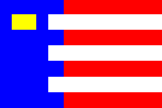


Example; Flag of Baarle-Nassau, The Netherlands (fotw);
Arms and Flag of Tunes, Portugal (fotw)
- BILLETTY
- The heraldic term sometimes used to describe a semé of billets – see
‘billet’ and
‘semé’.
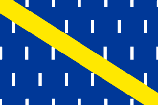


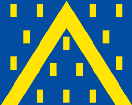
Flag of
Chastre, Belgium (fotw); Arms of
Vodice, Slovenia (fotw); Flag of
Franche-Comté; France (fotw); Flag of
Kampenhout, Belgium (fotw)
- BIRLINN
- See ‘lymphad’.

Badge of The Western Isles Council, Scotland



































![[Betsy Ross flag]](../images/v/vxt-d502.gif)




![Bicolour [Poland]](../images/v/vxt-d522.gif)
![Bicolour [Haiti]](../images/v/vxt-d522a.gif)
![Bicolour [Portugal]](../images/v/vxt-d522b.gif)
![Bicolour [Rome]](../images/v/vxt-d522c.gif)
![Bicolour [Sicily]](../images/v/vxt-d522d.gif)
![Bicolour [Bhutan]](../images/v/vxt-d522e.gif)











![[becket]](../images/v/vxt-d038a.gif)


![[Bethel flag]](../images/v/vxt-d040a.gif)
![[Bethel flag]](../images/v/vxt-d040.gif)